|
National City & Otay Railroad Depot
Historic assessment report by Kathleen Flanigan, October 1999
Revised & updated 2007 by Bruce Coons
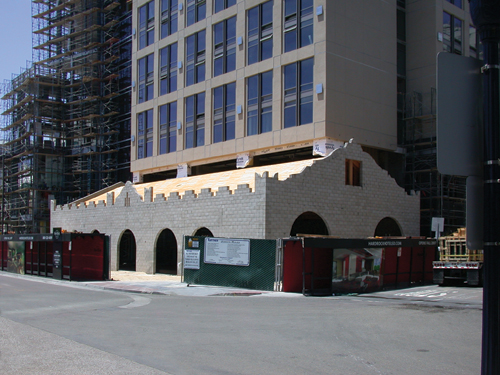
National City & Otay Depot under reconstruction, 6th Avenue and K Street, awaiting installation of its original brick, the application of stucco, tin roof, and star window.
|
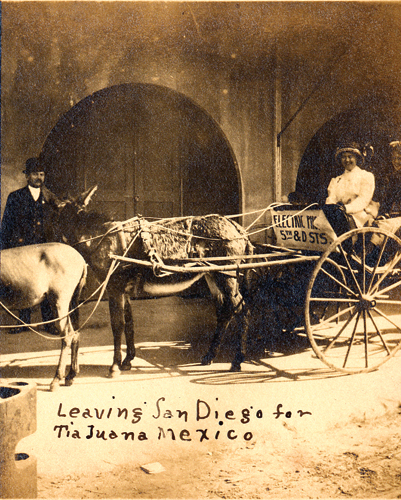
Catching the train to Tia Juana, a passenger is dropped off at the NC&O depot by a taxi from a local hotel, c. 1900.
|
The National City and Otay Railway (NC&O) was formed on December 26, 1886, by the San Diego Land & Town Company, a subsidiary of the Santa Fe Railroad. The NC&O provided transportation for equipment and men to build the Sweetwater Dam in 1888 and, as the first commuter railroad in San Diego, accommodated passenger transportation needs for business and pleasure from the main depot at 5th Avenue and L Street and from 1896 onward from the depot at 6th Avenue and L Street to points south extending to the Mexican border.1 The line connected with other San Diego railroad lines and the Pacific Coast Steamship Company's 5th Avenue wharf.2
The railroad brought county residents to downtown theatres and these 'theatre trains' proved to be extremely popular, as did the 'picnic trains' from San Diego that took residents down the line to the Sweetwater Valley extension for festive events at Linwood Grove near Bonita and the Sweetwater Dam, which was a major tourist attraction. U.S. Grant, Jr. built a Dutch Colonial style cottage designed by William Sterling Hebbard overlooking the dam in 1895. He erected his own station in the Greek Revival style on that connection and called it Aloha, after his ranch of the same name. Local denizens thronged to Tijuana via this railway line to the bullfights and prizefights, which were at least once, in 1888, refereed by then San Diego resident Wyatt Earp.1
In 1909 John D. Spreckels acquired the line and merged it with the Coronado Railroad to form the San Diego Southern Railroad (SDSRR). In 1912, the San Diego and Cuyamaca Eastern was combined with the SDSRR to form the San Diego and Southwestern Railroad (SD&SRR) and in 1917 it was sold to the San Diego and Arizona Eastern Railroad, yet another of Spreckels interests.3 The NC&O, which was electrified in 1907, is the predecessor of today's trolley, and is now controlled by the Metropolitan Transportation Development Board (MTDB), the San Diego Trolley.
The Building of the Depot
Prior to the building of the NC&O depot at 6th & L in 1896, an earlier rented site had been utilized as a depot at 5th & L. Mention of plans for the construction of a new edifice was found in the August 22, 1895, edition of The San Diego Union, which reported that "The San Diego Saving Bank is figuring on the erection of a fine building at Sixth and L Streets to be partly occupied by the National City & Otay Railway Company as a freight and passenger depot. The present depot at Fifth and L is on rented ground, and is too small for the business, and the company made overtures to the bank to build a two or three story building on the adjoining corner. The bank owns the lot, which is 50 x 100 feet...and if any building were created it would be a good one."
The National City Record of January 30, 1896, wrote "The National City and Otay Railroad is to have a new depot built on the vacant lot adjoining the present depot. Facing on Sixth Street in San Diego, it will be a brick building, 50 x 100, one story high, after the style of the M.C. Nason Block on Fifth. It will have a pressed brick front and when completed will present a fine appearance and improve materially the looks of lower Sixth Street. There will be the necessary offices and waiting rooms. One of the features of the new depot will be the large area of storage ground for all kinds of freights, especially of a perishable nature such as fruit, etc. It is expected that a large force of men will be put to work on the building next month and that it will be ready for occupancy by the first of May."
The Southwest Builder and Contractor in February 1896 identified William Sterling Hebbard as the architect "engaged to design the railway company's depot and warehouse in 1896."
The National City Record announced in April 1896, "The National City and Otay Railroad Company occupied their fine depot at the foot of 6th Street, San Diego, last week. The new building is commodious and convenient alike for freight and passengers." This was Hebbard's first truly Mission Revival style building in San Diego as well as one of the earliest depots of this design in California.4
Architect and Architecture
Architect William Sterling Hebbard independently or in partnership with Irving Gill was always on the cutting edge of architecture in San Diego, from his arrival in 1890 until he moved to Los Angeles in 1918. A graduate of the Cornell University School of Architecture in 1887, Hebbard interned from 1887-1888 with the famed architectural firm of Burnham and Root in Chicago headquartered in their Rookery Building, which combined Richardsonian Romanesque, Classical and Hindu styles of architecture.
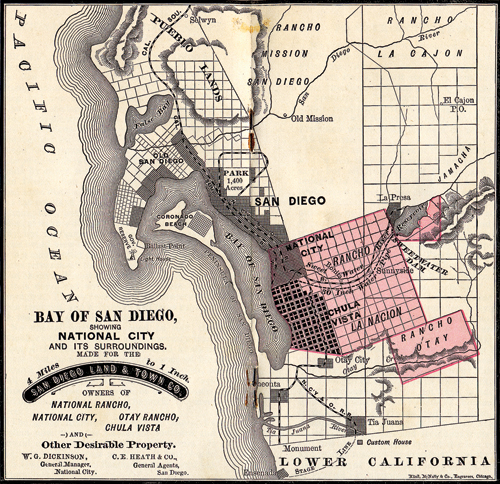
Map of the lands owned by the San Diego Land & Town Company and route of the National City & Otay Railroad.
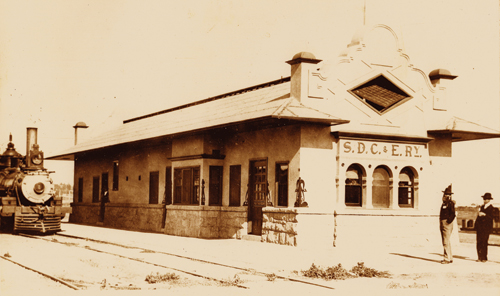
Another early San Diego Mission Revival depot, now lost. This was the San Diego Cuyamaca & Eastern Railway Depot. It was just east of the Santa Fe Depot on Broadway. The SDC&E ran from there and terminated at Foster, above Lakeside. This line was once projected to go to Julian.
|
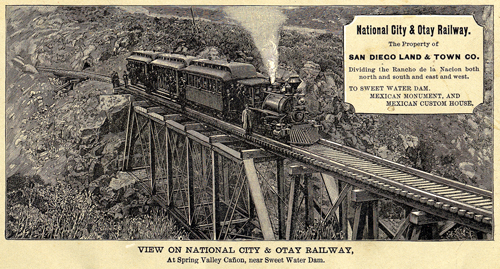
Illustration from a San Diego Land & Town Company promotional brochure, c. 1880's.
|
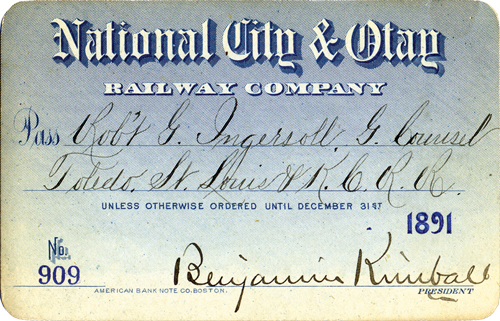
1897 pass made out to Robert Ingersoll, General Council. Mr. Ingersoll was one of the most famous and infamous attorneys of the 19th century, representing politicians, rogues and railways in Washington D.C. The pass is signed by Benjamin Kimball, President of the NC&O, no relation to the Kimball brothers of National City.
|
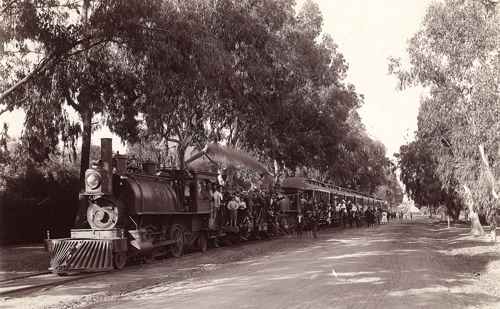
Sweetwater "Dam Train" on 24th Street, National City. Stopping for lunch at Flora and Warren Kimball's estate "Olivewood," 1890's.
|
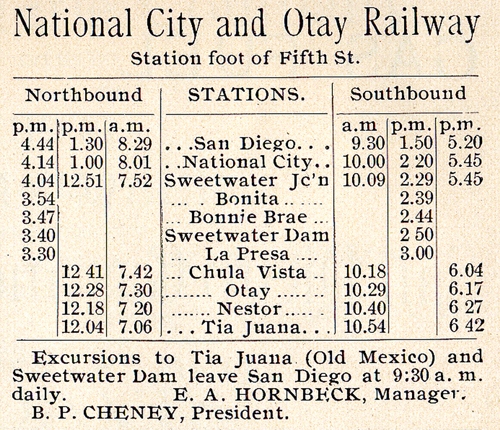
Time Table showing major stops along the line, c.1890's.
|
In 1888 Hebbard came west to Los Angeles and found employment with Curlett, Eisen and Cuthbertson, who designed the English Gothic and Richardsonian Romanesque Los Angeles County Courthouse, which was under construction during this period. William Cuthbertson, like other California architects, showed an interest in the old California Missions and spent much time in that area sketching them.4 Hebbard obviously received the Mission inspiration from Cuthbertson as his independent work in San Diego exhibits this.
Hebbard's first building, the San Diego Cable Railway Company's powerhouse, was completed in early 1890 and located on Spruce between Third and Fourth Streets. It featured an early Romanesque/Mission Revival style. Constructed of brick with many arched windows and arched entry, the structure featured a central second story tower with a pagoda styled hipped roof.5, 6 His second Mission Revival structure, a Unitarian church in San Diego, which was built in 1896 has been demolished.
Even though Hebbard used other creative styles and designs in his buildings during the 1890s, he continued his exploration with what was to become known as Mission Revival. Other Hebbard buildings in the Romanesque/Mission Revival include the Ramona Town Hall, built in 1893, which incorporated the use of two building materials, adobe and brick in its exterior walls, with a wide arched entry and two arched windows on either side; and the brick Clemens/Cobb Warehouse on 5th and K, built in 1894, which also featured an arched entry and arched windows on either side.5
Mission Revival offered much for the big railroad lines like the Santa Fe and the Southern Pacific. Karen Weitze wrote "both lines were thoroughly immersed in regional promotion: a Mission style furnished appropriate imagery for the depots. In the first decade of the twentieth century, other railway companies also launched a depot-building program. Between 1900 and 1920 Mission Revival became the style not only for California stations, but also for depots erected through the Southwest."4
The Depot exhibited an early Mission Revival approach, which reached its greatest popularity after the turn of the twentieth century. Historic photographs show a Mission gabled roof on the 6th Avenue side of the stucco over brick structure embellished with a striking quatrefoil window and two arched entries; the L Street side featured an elaborate Mission Revival parapet motif with two arched passenger entries. The building maintained its original style into the 1920s when the William Darby Company moved into the structure in 1924. The San Diego Union commented on Darby's new headquarters, "this business, which offered an extensive line of standard brands of roofing, brick, tile, plaster, button lath cement and other building specialties."5
Today
The Depot is Hebbard's only existing building of such an early architectural style in this state and was probably the first produced in San Diego of this type. It is one of the earliest depots of this style in California and is now being reclaimed and reconstructed.
Much of the brickwork and its quatrefoil window on the 6th Avenue side will be present in the reconstruction. The elaborate Mission Revival decorative elements are being recreated. The reconstitution of this building will fill in an important link in our architectural heritage, as it provides the only architectural reminder of this important part of our city's early transportation history and the NC&O Rail Road presence in San Diego County.
The depot will serve as the bar for the new Hard Rock Hotel.
Footnotes & Bibliography
1National City Record, 2/17/1887, 6/16/1887, 5/7/1888, 3/5/1895, 1/30/1896, 5/7/1896, 8/2/1896.
2Carrico, Susan & Kathleen Flanigan. San Diego's Historic Gaslamp Quarter: Then and Now. San Diego: Goodway Printing and Graphics, 1989.
3Hanft, Robert M. San Diego & Arizona: The Impossible Railroad. Glendale, CA: Interurban Press, 1985.
4Weitze, Karen California Mission Revival. Los Angeles: Hennessey & Ingalls, 1984.
5San Diego Union, 5/21/1893, 4/1/1894, 9/3/1894, 8/22/1895, 2/23/1913, 5/11/1894.
6Dodge, Richard V. Rails of the Silver Gate: the Spreckels San Diego Empire, San Marino: California Golden West Books, 1960.
Brown, Christian N. "Hey-dey of the NC&O." San Diego Historical Society Quarterly April 1951.
Coons, Bruce & Delores Mellon. Station and General Office Building, California Southern Railroad. National City, San Diego County California, National Register Form prepared for architect Milford Wayne Donaldson, 1996.
Coons, Bruce D. Brief History of the California Southern Railroad Relating to Rancho Santa Margarita y Las Flores and the Temecula Canyon National Register Report, March 1996.
Dodge, Richard V. "San Diego's Grip Cars," Dispatcher, May 1962.
Flanigan, Sylvia Kathleen William Sterling Hebbard: Consummate California Architect. Master's Thesis, University of San Diego, 1985.
Forty, Ralph San Diego South Bay Interurban, Glendale, CA: Interurban Press, 1987.
Sanborn Fire Map.
Southwest Builder & Contractor, 2/12/1896.
Whiffen, Marcus and Frederick Koeper American Architecture. Cambridge: The MIT Press, 1893. |
MORE FROM THIS ISSUE
The Broadway Fountain
San Diego's Historic Warehouse District
Just the Facts
National City & Otay Railroad Depot
The Inside Story
2007 Most Endangered List
Sim Bruce Richards
2007 People In Preservation Award Winners
Baseball Returns Downtown
Reflections
Lost San Diego
Strength in Numbers
Advertisements
DOWNLOAD full magazine as pdf (24mb)
|











